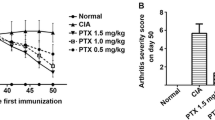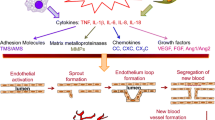Abstract
As mononuclear cell infiltration and growth of pannus critically depend on synovial neovascularization in rheumatoid arthritis (RA), inhibition of the synovial blood vessels would have the potential to reduce rheumatoid inflammation. In this investigation, we studied the effect of gold sodium thiomalate (GST) and auranofin (AUR) on neovascularization in vivo by using a micropocket technique. Both GST and AUR suppressed rabbit corneal neovascularization in a dose-dependent fashion. Significant inhibition was observed by 3 mg/kg GST and 1 mg/kg AUR injected intravenously every other day. These injections maintained serum gold concentrations at the level of 2–5 μg/ml and less than 2 μg/ml in GST-and AUR-injected rabbits, respectively. These are concentrations attained in the serum or synovium of rheumatoid patients treated by gold compounds. Similar inhibition was observed by both intramuscular administration of GST and oral administration of AUR. In contrast, no inhibition was observed when non-steroidal anti-inflammatory drugs (NSAIDs; 20 mg/kg acetylsalicylic acid, 10 mg/kg ibuprofen and 10 mg/kg indomethacin) were injected intravenously on a daily basis. These results suggested that gold compounds have an antiangiogenic effect in vivo. The inhibition of neovascularization by gold compounds suggested that they may suppress rheumatoid synovitis by reducing the number of small blood vessels required for mononuclear cell infiltration and synovial tissue proliferation.
Similar content being viewed by others
References
Folkman J (1985) Tumor angiogenesis. Adv Cancer Res 43:175–203
Folkman J, Ausprunk D, Langer R (1985) Connective tissue; small blood vessels and capillaries. In: Kelley MN, Harris ED Jr Ruddy S, Sledge CB (eds) Textbook of Rheumatology, 2nd edn. Saunders, Philadephia, pp 197–210
Zvaifler NJ (1973) The immunopathology of joint inflammation in rheumatoid arthritis. Adv Immunol 16:265–336
Ashida ER, Johnson AR, Lipsky PE (1981) Human endothelial cell-lymphocyte interaction. Endothelial cells function as accessory cells necessary for mitogen-induced human T lymphocytes activation in vitro. J Clin Invest 67:1490–1499
Pober JS, Gimbrone MA Jr, Cotran RS, Reiss CS, Burakoff SJ, Fiers W, Ault KA (1983) Ia expression by vascular endothelium is induced by activated T cells and by human ψ-interferon. J Exp Med 157:1339–1353
Masuyama J, Minato N, Kano S (1986) Mechanisms of lymphocyte adhesion to human vascular endothelial cells in culture: T lymphocyte adhesion to endothelial cells through endothelial HLA-DR antigens induced by gamma interferon. J Clin Invest 77:1596–1605
Miossec P, Cavender DE, Ziff M (1986) Production of interleukin 1 by human endothelial cells. J Immunol 136:2486–2491
Jirik FR, Podor TJ, Hirano T, Kishimoto T, Loskutoff DJ, Carson DA, Lotz M (1989) Bacterial lipopolysaccharide and inflammatory mediators augment IL-6 secretion by human endothelial cells. J Immunol 142:144–147
Cooperating Clinics Committe of the American Rheumatism Association (1973) A controlled trial of gold salt therapy in rheumatoid arthritis. Arthritis Rheum 16:353–358
Lipsky PE, Ziff M (1982) The mechanisms of action of gold and D-penicillamine in rheumatoid arthritis. Adv Inflamm Res 3:219–235
Spalding DM, Darby WL III, Heck LW (1986) Alterations in macrophage collagenase secretion induced by gold sodium thiomalate. Arthritis Rheum 29:75–81
Sanders KM, Carlson PL, Littman BH (1987) Effect of gold sodium thiomalate on interferon stimulation of C2 synthesis and HLA-DR expression by human monocytes. Arthritis Rheum 30:1032–1039
Littman BH, Schwartz P (1982) Gold inhibition of the production of the second complement component by lymphokinestimulated human monocytes. Arthritis Rheum 25:288–296
Koch AE, Cho M, Borrows J, Leibovich SJ, Polverini PJ (1988) Inhibition of production of macrophage-derived angiogenic activity by anti-rheumatic agents gold sodium thiomalate and auranofin. Biochem Biophys Res Commun 154:205–212
Matsubara T, Ziff M (1987) Inhibition of human endothelial cell proliferation by gold compounds. J Clin Invest 79:1440–1446
Matsubara T, Saura R, Hirohata K, Ziff M (1989) Inhibition of human endothelial cell proliferation in vitro and neovascularization in vivo by D-penicillamine. J Clin Invest 83:158–167
Langer R, Folkman J (1976) Polymers for the sustained release of proteins and other macromolecules. Nature 263:797–800
Mascarenhas BR, Granda JL, Freyberg RH (1972) Gold metabolism in patients with rheumatoid arthritis treated with gold compounds: reinvestigated. Arthritis Rheum 15:391–402
Gimbrone MA Jr, Leapman SB, Cortan RS, Folkman J (1973) Tumor angiogenesis: iris neovascularization at a distance from experimental intraocular tumors. J Natl Cancer Inst 50:219–228
Gimbrone MA Jr, Cortan RS, Leapman SB, Folkman J (1974) Tumor growth and neovascularization: an experimental model using the rabbit cornea. J Natl Cancer Inst 52:413–427
Hale LP, Martin ME, McCollum DE, Nunley JA, Springer TA, Singer KH, Haynes BF (1989) Immunohistologic analysis of the distribution of cell adhesion molecules within the inflammatory synovial microenvironment. Arthritis Rheum 32:22–30
Haynes BF, Grover BJ, Whichard LP, Hale LP, Nunley JA, McCollum DE, Singer KH (1988) Synovial microenvironment-T cell interactions: human T cells bind to fibroblast-like synovial cells in vitro. Arthritis Rheum 31:947–955
Pober JS, Gimbrone MA Jr, Lapierre LA, Mendrick DL, Fiers M, Rothlein R, Springer TA (1986) Overlapping patterns of activation of human endothelial cells by interleukin 1, tumor necrosis factor, and immune interferon. J Immunol 137:1893–1896
Grahame R, Billings R, Laurence M, Marks V, Wood PJ (1974) Tissue gold levels after chrysotherapy. Ann Rheum Dis 33:536–539
Goddard DH, Grossman SL, Williams WV, Weiner DB, Gross JL, Eidsvoog K, Dasch JR (1992) Regulation of synovial cell growth. Coexpression of transforming growth factor β and basic fibroblast growth factor by cultured synovial cells. Arthritis Rheum 35:1296–1303
Sato Y, Rifkin DB (1988) Autocrine activities of basic fibroblast growth factor: regulation of endothelial cell movement, plasminogen activator synthesis, and DNA synthesis. J Cell Biol 107:1199–1205
Leibovich SJ, Polverini PJ, Shepard HM, Wiseman DM, Shively V, Nuseir N (1987) Macrophage-induced angiogenesis is mediated by tumor necrosis factor-α. Nature 329:630–632
Koch AE, Polverini PJ, Leibovich SJ (1986) Stimulation of neovascularization by human rheumatoid synovial tissue macrophages. Arthritis Rheum 29:471–479
Koch AE, Kunkel SL, Polverini PJ, Harlow LA, DiPietro LA, Elner VM, Elner SG, Strieter RM (1992) Interleukin-8 is a potent human macrophage-derived mediator of angiogenesis that is blocked by interleukin-8 antibody and antisense oligonucleotide. Arthritis Rheum 35:S49
Kimura T, Mitsuka T, Takahashi N, Matsubara T, Hirohata K (1991) Disease-modifying anti-rheumatic drug (D-MARD)-induced inhibition of basic fibroblast growth factor (bFGF) production by human endothelial cells (ECs). Arthritis Rheum 34:S159
Author information
Authors and Affiliations
Rights and permissions
About this article
Cite this article
Saura, R., Matsubara, T. & Mizuno, K. Inhibition of neovascularization in vivo by gold compounds. Rheumatol Int 14, 1–7 (1994). https://doi.org/10.1007/BF00302664
Received:
Accepted:
Issue Date:
DOI: https://doi.org/10.1007/BF00302664




